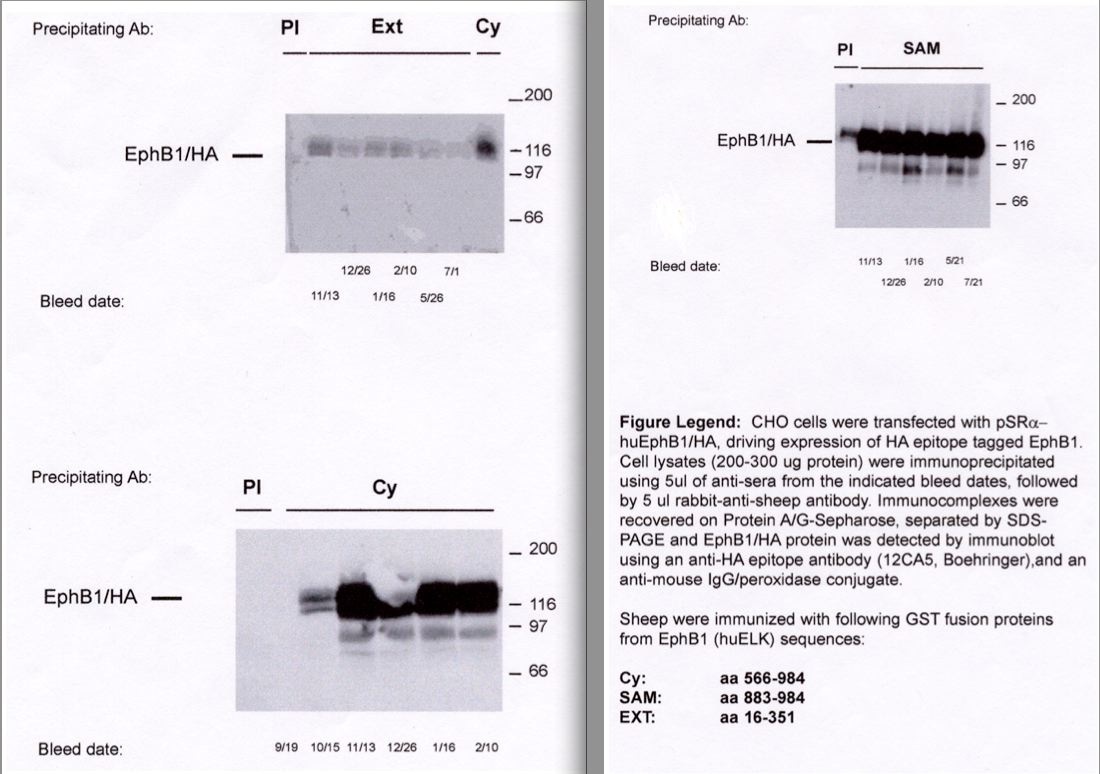Catalogue

Sheep anti Human ELK rec tyr Kinase (Eph B1 Cy.)
Catalog number: S110P| Isotype | IgG |
| Product Type |
Polyclonal Antibody |
| Units | 250 µg |
| Host | Sheep |
| Species Reactivity |
Human |
| Application |
Immunoprecipitation |
Background
The immunogen used for the anti-human ephB1 (Elk receptor) Ðcytoplasmic(CY) region was a GST fusion protein ephB1 (Elk receptor) CY corresponding to amino acid sequence 586-984 of the C terminal, cytoplasmic region and having a molecular weight of 116 kDa. EphB1, previously known as Elk (eph-like kinase), is a receptor tyrosine kinase of the highly tissue restricted family of eph proteins. EphB1 and other ephB family members are type 1 membrane spanning proteins, comprised of immunoglobulin, fibronectin type III, and cysteine rich subdomains in the ecto domain, and the single uninterrupted cytoplasmic tyrosine kinase domain upstream of a carboxyterminal sterile alpha motif (SAM) domain. EphB family proteins bind ephrins of the B class, ligands that are also transmembrane spanning proteins capable of transmitting signals. EphB1 is expressed predominantly in developing neural structures in embryos, and in vascular epithelium of kidney, and other tissues. Upon binding to alternatively oligomerized ephrin B1, ephB1 signals regulation of cell attachment and cell-cell assembly. Members of this protein family are implicated in neuronal and vascular cell targeting.
Synonyms: Eph B1 (ELK receptor) cytoplasmic; Tyrosine-protein kinase receptor EPH-2; Ephrin type B receptor 1; HEK6
Source
Immunogen: A GST fusion protein ephB1 (Elk receptor) - CY corresponding to amino acid sequence 586-984 of the C terminus region and having a molecular weight of 116 kDa
Product
Product Form: Unconjugated
Formulation: Provided as solution in phosphate buffered saline with 0.08% sodium azide
Purification Method: Ammonium Sulfate Precipitation
Concentration: See vial for concentration
Applications
Applications: 1-10 ug/ml for Western Blotting and 10-20 ug/ml for immunoprecipitation.
Functional Analysis: Western Blotting
Positive Control: Human brain
Storage
Product should be stored at -20°C. Aliquot to avoid freeze/thaw cycles
Product Stability: See expiration date on vial
Shipping Conditions: Room Temperature
Caution
This product is intended FOR RESEARCH USE ONLY, and FOR TESTS IN VITRO, not for use in diagnostic or therapeutic procedures involving humans or animals. It may contain hazardous ingredients. Please refer to the Safety Data Sheets (SDS) for additional information and proper handling procedures. Dispose product remainders according to local regulations.This datasheet is as accurate as reasonably achievable, but Nordic-MUbio accepts no liability for any inaccuracies or omissions in this information.
References
1. Stein, E., et al. 'Nck recruitment to Eph receptor, EphB1/ELK, couples ligand activation to c-Jun kinase.' J. Biol. Chem., 273, 1303-1308 (1998)
2. Han, D.C., et al. 'EphB1 associates with Grb7 and regulates cell migration.' J. Biol. Chem., 277, 45655-45661 (2002)
3. Vindis, C., et al. 'EphB1 recruits c-Src and p52Shc to activate MAPK/ERK and promote chemotaxis.' J. Cell Biol., 162, 661-671 (2003)
Protein Reference(s)
Database Name: UniProt
Accession Number: P54762 (Human)
Species Accession: Human
Safety Datasheet(s) for this product:
| NM_Sodium Azide |

"Legend: CHO cells were trasfected with pSR-α huEphB1/HA, driving expression of HA epitope tagged EphB1. Cell lysates (200-300µg protein) were immunoprecipitated using 5 µl rabbit-anti-sheep antibody. Immunocomplexes were recovered on Protein A/G-Sepharose, separated by SDS-PAGE and EphB1/HA protein was detected by immunoblot using an anti-HA epitope antibody (Cat. No. X1000), and an anti-mouse IgG/peroxidase conjugate. Sheep were immunized with the following GST fusion proteins from EphB1 (huELK) sequences: Cy: aa 566-984 SAM: aa 883-984 EXT: aa 16-351"

